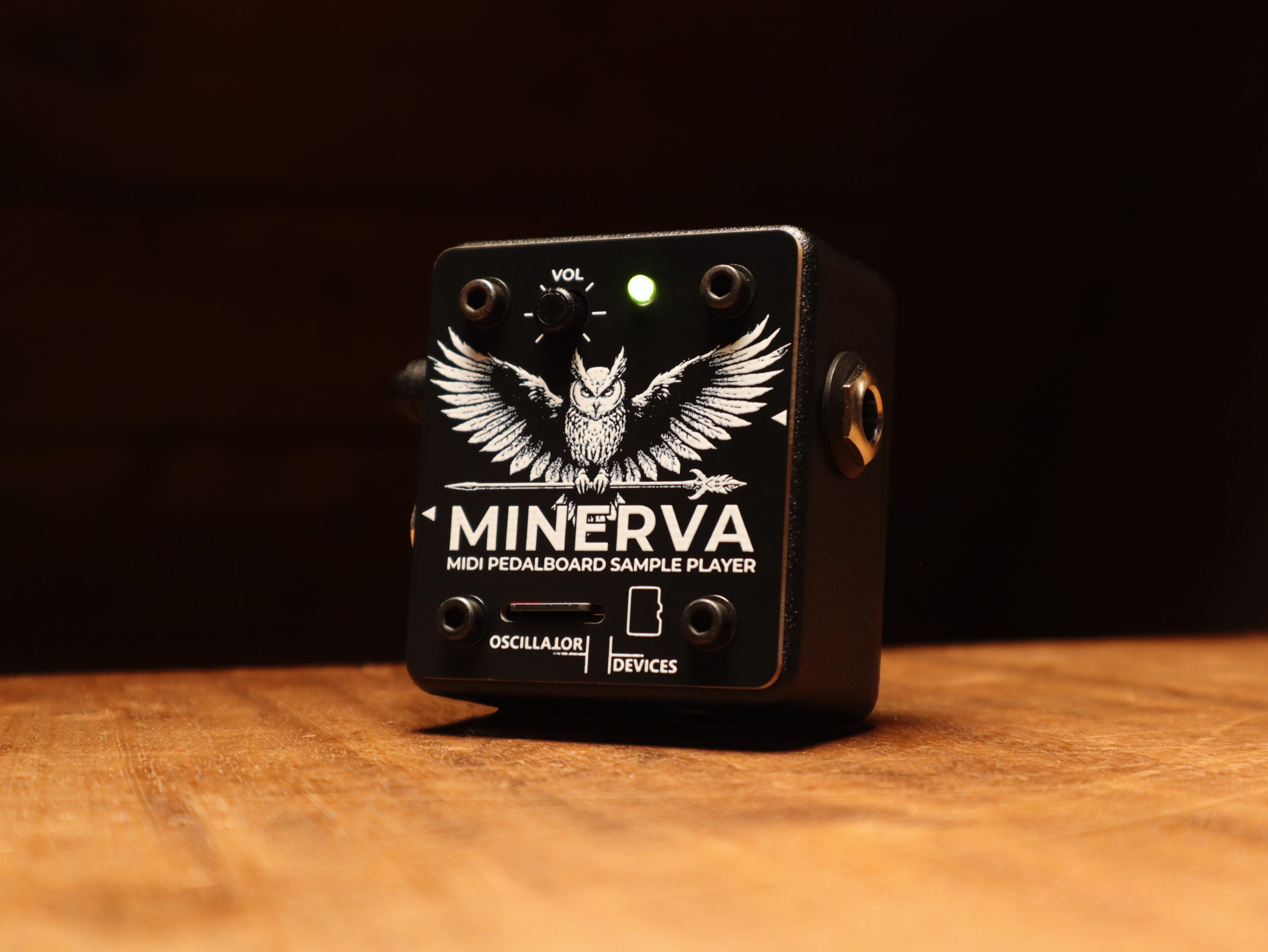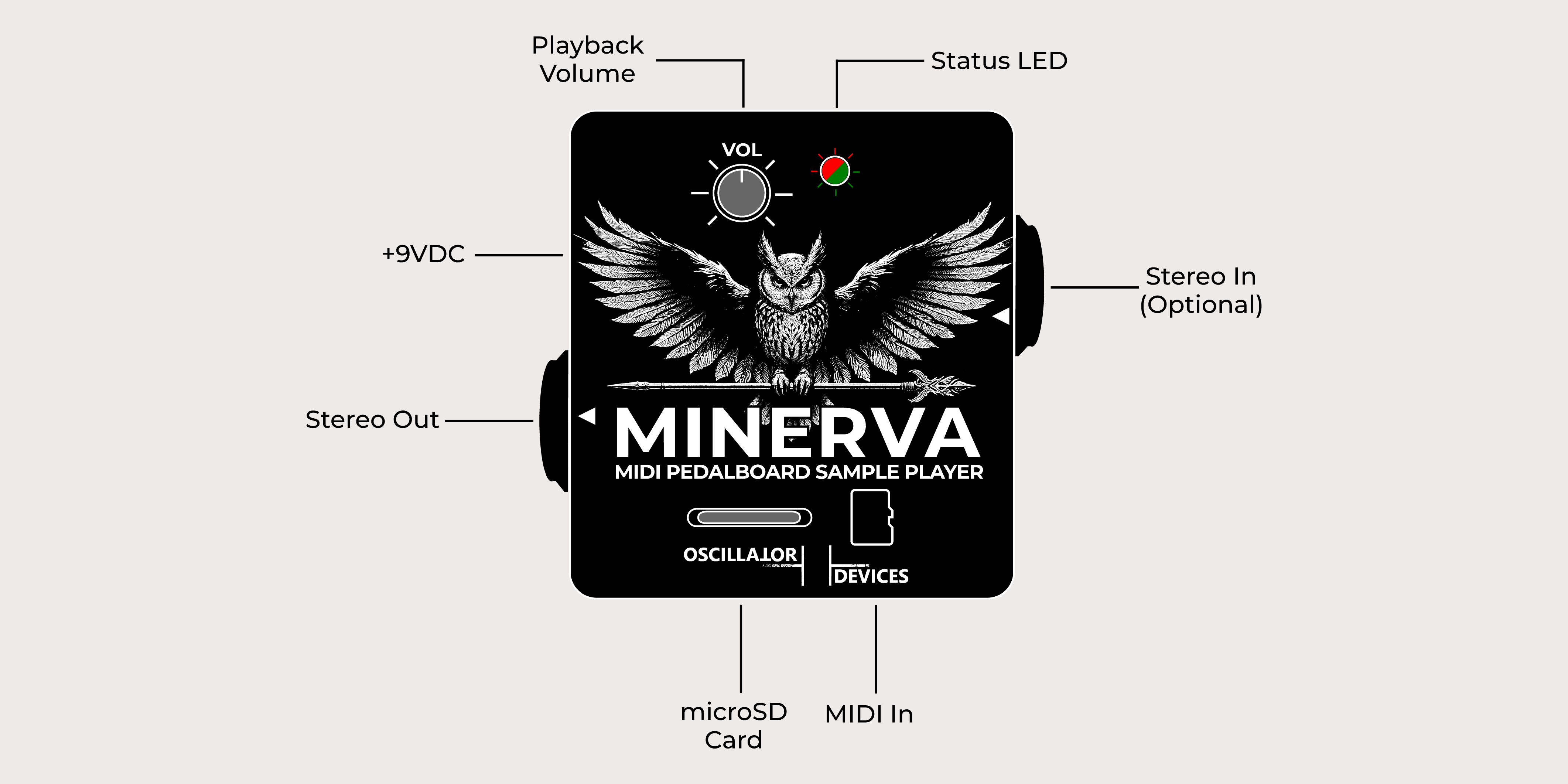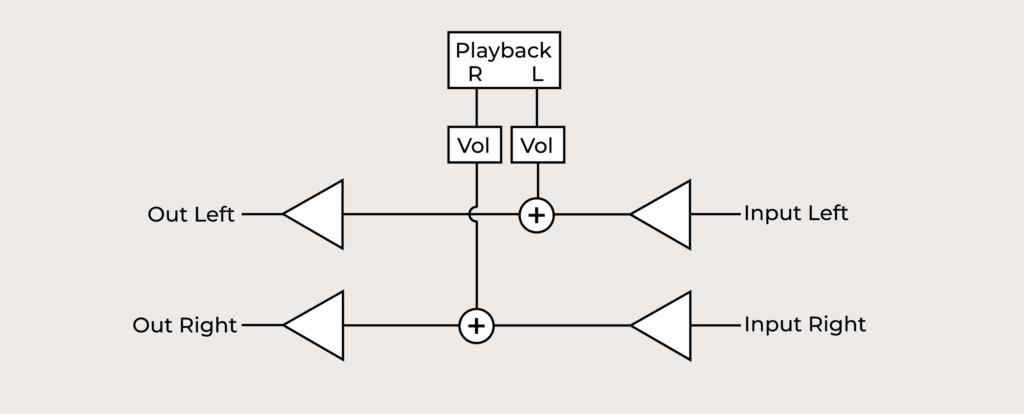The Oscillator Devices MINERVA – MIDI Sample Player is a compact, MIDI controlled, stereo sample player. The MINERVA offers stereo playback of .WAV and .AIFF files with different sample rates and bit depths. The ability to mix the output with an optional guitar, bass, or synth input signal makes it perfect for the use on a MIDI controlled pedalboard. Of course the MINERVA is analog dry-through. That means the input signal stays analog and is free from any A/D or D/A conversion.
The samples are saved on a microSD or microSDHC card, easily accessible from the top. The samples can be triggered with PC, selectable CC or Note commands. With the latter it’s possible to control the MINERVA with a MIDI keyboard.
Features:
- Stereo playback of WAV and AIFF files via 1/4″ stereo output
- True analog dry-through: input signal remains fully analog and unprocessed
- Ultra-compact footprint: only 60mm x 55mm x 35mm — ideal for pedalboards
- Supports up to 400 tracks or 32GB of audio data
- Top-access microSD/microSDHC card slot for easy sample management
- Trigger samples via Program Change (PC), Control Change (CC), or Note messages
- MIDI Clock synchronization support
- Override sample rate to adjust speed and pitch in real time
- Mono mixdown option for mono setups
- Reverse playback support
- Selectable MIDI channel
- Assignable CC commands for MIDI channel sharing
- Compatible with all MIDI 1.0 compliant controllers and software
- Built with high-quality Neutrik connectors
- Designed and hand-built in Germany by Oscillator Devices

Applications
The MINERVA – MIDI Sample Player features a 1/4″ stereo input jack. You can connect any stereo audio source to it, and the signal will pass through unaltered when no playback is active. During playback, the input signal is mixed with the audio file being played. This makes the MINERVA ideal for integration at any point in your signal chain.
Place it last in your chain to play backing tracks, intros, outros, or ambient sounds directly through your guitar speaker. If you’re using a modeler that feeds directly into the PA system, place the MINERVA after it to ensure an unaltered audio signal is sent to the speakers.
If you want to trigger sound effects or small guitar parts during performance, you can place the MINERVA at the start of your signal chain, allowing you to apply effects to the playback.

Of course, you can also omit the input signal and feed the MINERVA’s output directly into a PA system or a small pedalboard mixer. Keep in mind, however, that the MINERVA features a high-quality, low-noise buffer with a 1MΩ input impedance, so placing it first in the chain can actually benefit your guitar’s signal.
Stereo vs. Mono
The MINERVA is a fully stereo MIDI sample player with two independent audio channels. These channels correspond directly to the left and right channels of the audio file. The left channel of the sample is mixed with the left input signal, and the right channel with the right input signal.

You can use the second channel to play a regular sample on one channel while simultaneously playing the exact same sample with a click track on the other channel. This allows you to feed the sample with the click to a drummer’s monitor.
But what if you’re using the sample player in a mono setup? No problem—the audio from the samples can be summed to mono.

Triggering the Samples
The MINERVA offers four different ways to trigger samples:
- You can simply copy your samples to the root folder of the SD card and trigger them using Program Change (PC) commands. These PC commands are mapped to the files alphabetically.
- Create folders with specific names to assign your samples to custom Control Change (CC) commands for more flexible triggering.
- Map your files to custom PC commands and use the increment feature to step through your files sequentially with a single PC command.
- Use MIDI Note commands to play files directly from a MIDI keyboard, for example. A unique feature is that if the exact file for a note is missing, the MINERVA automatically searches for adjacent files and adjusts the sample rate so the correct pitch is played. You can have up to 128 different note sets and switch between them using PC commands.
Samples can also be triggered automatically. You can repeat individual files or entire folders, or synchronize playback to MIDI clock. For example, you could use a hi-hat sample and have it play perfectly in time with MIDI clock and use the MINERVA as a MIDI controlled metronome and click source for your in ear monitoring.
Note that the MINERVA is monophonic, so when a sample is triggerered while another is playing, the playing sample is stopped.
File Formats
The MINERVA can playback .WAV-Files with the following specifications:
- Channels: Up to 2 (Mono and Stereo).
- Sample Rate: 44.1kHz or 48kHz.
- Bit depth: 16-Bit, 24-Bit or 32-Bit floating point
The MINERVA can playback uncompressed (PCM) .AIFF/.AIF-Files with the following specifications:
- Channels: Up to 2 (Mono and Stereo).
- Sample Rate: 44.1kHz or 48kHz.
- Bit depth: 16-Bit, 24-Bit or 32-Bit.
SD Cards
The MINERVA reads samples from a SD card easily accessible from the top. The SD card has to be a microSD or microSDHC card with a maximum size of 32GB. The size limitation is due to the size limitation of the microSDHC format. Larger cards all have the microSDXC format, that uses the exFAT file system, which is subject to licensing restrictions from Microsoft Corp. The SD Card has to be formatted with the FAT32 file system.
Configuration
The MINERVA offers several useful features, such as MIDI channel sharing and mono summing. These can be enabled or disabled via a configuration file — a simple text file placed on the SD card that the MINERVA reads and interprets. If this file is missing, the device defaults to factory settings, which are ideal for typical use.
MIDI Channel Sharing
“I’m out of MIDI channels!” — we hear that often. The struggle is real. With only 16 MIDI channels, managing a larger pedalboard can be challenging. That’s why the MINERVA supports channel sharing by allowing customization of Control Change (CC) commands. As mentioned earlier, sample-triggering commands can be customized by folder names, and all other CC commands are also fully configurable.
MIDI Metronome
The MINERVA can double as a metronome or a MIDI Clock-to-Click translator. It features a dedicated option to function as an auto-start metronome, which automatically plays the first track on the SD card as quarter notes synced to the incoming MIDI clock — no additional MIDI commands needed.
MIDI Connection
The MINERVA uses the official MIDI TRS standard (Type A), just like pedals from Boss or Wampler. It connects via a 1/8″ (3.5 mm) stereo jack plug. Note that the MINERVA does not provide MIDI Thru functionality.
